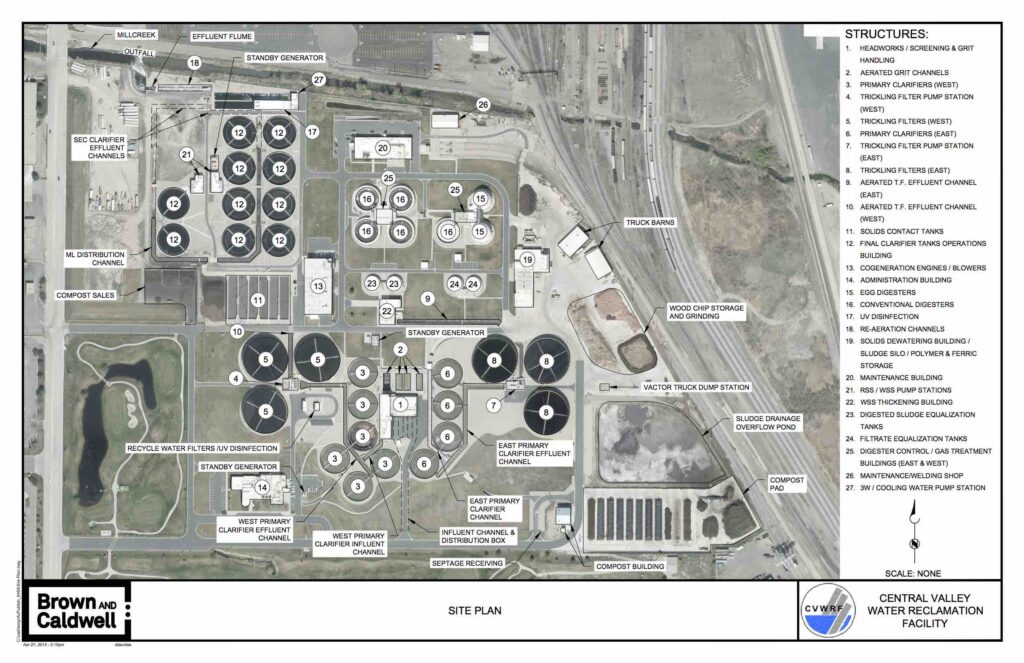Wastewater Treatment Process
The Central Valley Water Reclamation Facility (CVWRF) treats wastewater using a combination of processes. Every day, between 50 and 60 million gallons of wastewater are collected and flow into the facility for treatment. Those millions of gallons of water are processed, impurities are separated and treated, and harmful bacteria, protozoa, and viruses are eliminated so that only clean water is returned to Mill Creek and the Jordan River.

CVWRF Entrance

CVWRF Aerial
Before the treated wastewater is released back into the environment, it must comply with strict discharge standards of the Utah Pollution Discharge Elimination System (UPDES) Permit issued to the CVWRF by the Utah Division of Water Quality (DWQ). The organic material and solids must be removed and the Biochemical Oxygen Demand (BOD), a measure of oxygen depletion, in the water must be reduced to a level safe enough to sustain the fish and other aquatic life of the receiving stream. In addition, ammonia and metals must be removed to safe levels and the water must be disinfected to remove pathogenic microorganisms to prevent the spread of disease.
The current flow capacity and effluent contaminant concentration permit limits are:
| Rated Flow Capacity | 75 million gallons per day (mgd) |
| Current Average Day Flow | 50 mgd |
| Secondary Irrigation Water Production | 1 mgd (April-October) |
| Carbonaceous Biochemical Oxygen Demand (CBOD) Limit | 16.0 mg/L (milligrams per liter) (maximum monthly) |
| Total Suspended Solids (TSS) Limit | 25 mg/L (maximum monthly) |
| Ammonia Limit | 3.7 to 5.8 mg/L (seasonal) |
| E. coli Limit | 126 CFU/100 mL (colony forming units per 100 milliliters) (maximum monthly) |
| Future Phosphorus Limit (implemented in 2025) | 1.0 mg/L (annual average) |
The CVWRF’s process is clean, safe, and requires less maintenance and energy to operate than other types of municipal wastewater treatment systems, delivering substantial benefits to the ratepayer. Additionally, the CVWRF is one of the few Utah facilities to use a digester gas/natural gas mixture to generate about 85 percent of its electricity needs in a cogeneration system. Waste heat from the engine generators is captured and used to heat the anaerobic digesters and to heat and air condition the treatment plant’s buildings, further reducing energy costs for the facility.
The CVWRF can turn contaminated water into clean water within 8 to 10 hours. The process is shown in 17 steps in the process diagram below and described in detail in the following sections. A site plan showing the layout of the buildings and major process units is also provided below.
The CVWRF Process Schematic – The Process Description below refers to the numbers on the Process Schematic.
Aerial Photograph and Site Plan of the CVWRF Treatment Plant
The overall water treatment process employed at the CVWRF includes preliminary treatment, primary clarification, trickling filters, activated sludge aeration tanks, secondary clarification, and effluent disinfection. The wastewater flows through the collection system to the treatment plant, where larger impurities are removed upfront in the screening and grit removal processes. Then the suspended organic solids are settled and the floating oils and grease (referred to as scum) are separated from the water in the primary clarifiers. Beneficial bacteria are grown and nurtured to consume the remainder of the fine (colloidal) suspended organic solids, dissolved organic material, and ammonia in the trickling filters and solids contact aeration tanks. The suspended organic solids are settled and separated once again from the water in the secondary clarifiers. Finally, the water flows to UV disinfection and post aeration prior to release.
Besides treating the wastewater, the CVWRF also treats the solid organic materials removed from the wastewater and the waste bacterial cultures used to treat the wastewater in the trickling filters and solids contact process. An anaerobic digestion process treats these solids by decomposition, which converts the solids to methane gas, carbon dioxide gas, and a stable residual material called biosolids. The methane gas is used to fuel the cogeneration system which supplies power and heat to run the plant. The liquid water is pressed out of the biosolids slurry and returned to the liquid portion of the plant for retreatment. About 30 percent of the dewatered biosolids are mixed with wood chips and composted to make an Exceptional Quality Class A compost that is sold to the public for landscaping and horticultural use. CVWRF’s compost products are marketed under the label Oquirrh Mountain Compost Products (OMCompost.com). The remainder of the dewatered biosolids are trucked from the treatment plant to a farm and land applied to supply nutrients and organic carbon for beneficial agricultural use.
In order to help run all of the equipment and processes, the CVWRF utilizes a Supervisory Control And Data Acquisition, (SCADA) system. The implementation of the SCADA system has a positive impact on the operations, maintenance, process improvement, and savings for the CVWRF. The term SCADA system can be used to describe a multitude of computer-based control systems that allow operators and facility personnel to monitor and control a facility’s equipment either locally or remotely. Typically, a SCADA system will automate much of the control process such that plant operators can focus on other tasks. The systems give the operator flexibility to manually control the equipment where desired. SCADA systems are also installed to collect and store information for reporting, troubleshooting, maintenance indications, and much more.

Control Room


